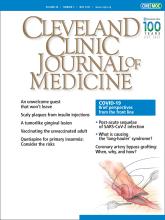
The SARS-CoV-2 pandemic, with its multiple surges, is seemingly lasting forever, although it has actually been with us for a little more than a year. Despite recent setbacks, with difficulties in vaccine production and with safety concerns over a rare but potentially fatal (and possibly autoimmune) platelet activation-related coagulopathy with thrombosis and thrombocytopenia syndrome,1 there is a sense that the end of the infection phase is within reach. Of course, tempering that optimism are the ongoing viral mutations that may exhibit increased virulence or vaccine resistance, and significant swaths of the population voicing “hesitancy” to get vaccinated and to wear a mask, which may slow the development of effective herd immunity.
But once the infectious phase of the pandemic eventually winds down, we will not be done with the pandemic. The effects of COVID-19 on our society and lifestyle and on our patients will linger far longer than the presence of infectious virions.
COVID-19 has had obvious direct and indirect effects on the fabric and behavior of our society in the United States, as well as internationally. The toll on the restaurant industry, on travel and tourism, on the entertainment industry, and on retail sectors of our economy has been striking and in some cases devastating—while at the same time warehousing, construction, and delivery sectors have boomed, and financial markets blossomed. The pandemic led to shortages of manufacturing supplies, while at the same time the need for selective products have skyrocketed. Conditions seem ripe to support a jump-started economic recovery in some sectors. But our economic and social landscapes will probably not be the same as before the pandemic.
As Christakis describes in his very readable book Apollo’s Arrow: The Profound and Enduring Impact of Coronavirus on the Way We Live, past pandemics have provoked lasting societal change. The COVID-19 pandemic will be similar, though it will affect the post-pandemic world in ways different from the Spanish flu or the bubonic plague, in part because of its higher mortality rate in older people. How much societal PTSD will be expressed? How will younger vs older adults react in a post-infection reality while awaiting the next viral iteration and, likely, recommendations for ongoing vaccinations? We will see scattered wearing of facial masks in high-trafficked areas of cities, as has been the case in Asia for years. White-collar businesses and education venues will continue to utilize virtual technology to a far greater degree than before. There will be broader acceptance of a work-from-home option in many areas of professional life, with subsequent impact on geographic resettling, child care needs, home remodeling, new construction, office real estate, and the use of dining and other shared community spaces.
In clinical practice, we have experienced the scrambling to offer, monetize, and expand the utilization of telemedicine, perhaps (in my mind) more broadly than clinically optimal. In medical education, undergraduate and postgraduate, we have rapidly needed to cope with the challenges and advantages of virtual conferencing. For our medicine grand round lecture series, it has been easier to schedule desired speakers, and I have been fortunate to recruit several from Europe, while being forced to avoid inviting those on our West Coast, who would need to speak at 4:00 am for those in our Eastern time zone. Consultant discussions, safety monitoring boards, and national education oversight committees have all met virtually. Travel expenses have almost disappeared.
But the adverse effects on the academic system are many and include the loss of personal interaction, dialogue with the opportunity to read facial expressions and body language, and interpersonal bonding. Trainees and other healthcare workers have experienced enormous emotional stress on the front lines, as well as the loss of educational opportunities and clinical experiences. The possibility for mentored introduction has almost disappeared, as has the opportunity for trainees and junior faculty to network with senior, nationally known academic leaders from other institutions. Still, stretched in ways we couldn’t have imagined, we have not seen the total demise of our academic system, and only time will tell how we re-emerge in what is likely to be a hybrid in-person and virtual reality.
The long-lasting adverse effects on patients who have been infected with and have survived COVID-19 is a bit of a surprise—a major-league knuckleball tossed at us by SARS-CoV-2. Lingering pulmonary symptoms, dyspnea, chest pain, and nagging cough are easy to understand: after all, SARS-CoV-2 is a respiratory virus capable of damaging respiratory cells. But the post-infection symptoms experienced by “long-haulers” extend far beyond the thorax, as discussed by Vehar et al on page 267 in this issue. It is tempting to explain away the lingering constitutional and cognitive symptoms without evidence of biochemical or organ damage as a “functional” response to the stress reaction, buoyed by societal insecurity and mixed-message politicalization of public health measures, as well as by the very real threat of infection with resultant severe illness or even death—all occurring in an environment of economic insecurity and, for many, social isolation.
But as discussed by Sigal on page 273, there are also very real and complex biologic factors at play after infection with this virus. He draws comparisons with other infections that have triggered similar, lasting complications. We do not yet understand most of them, but research is elucidating the roles of specific cytokine reactions, abnormal activation of the clotting cascade, and stimulation and damage of the vasculature.
- Copyright © 2021 The Cleveland Clinic Foundation. All Rights Reserved.






